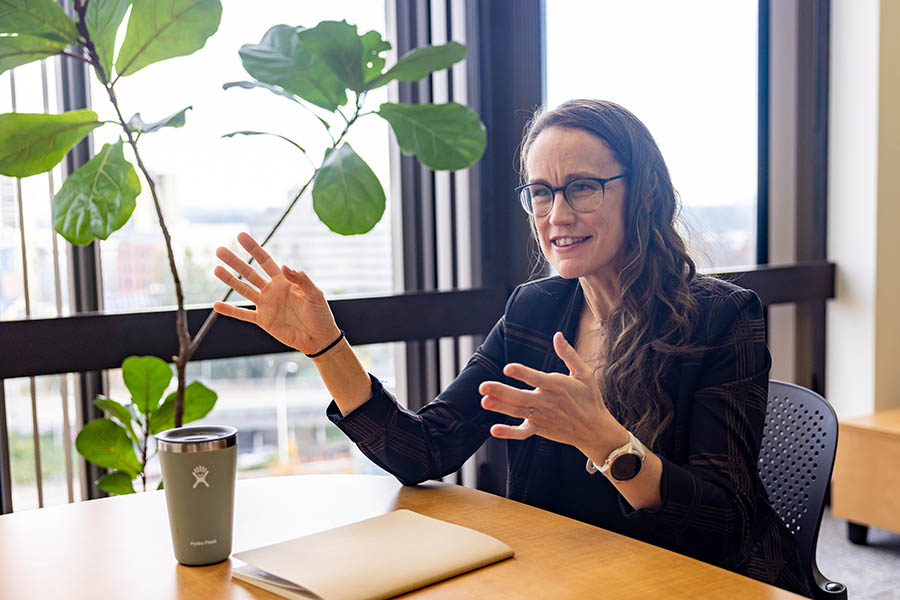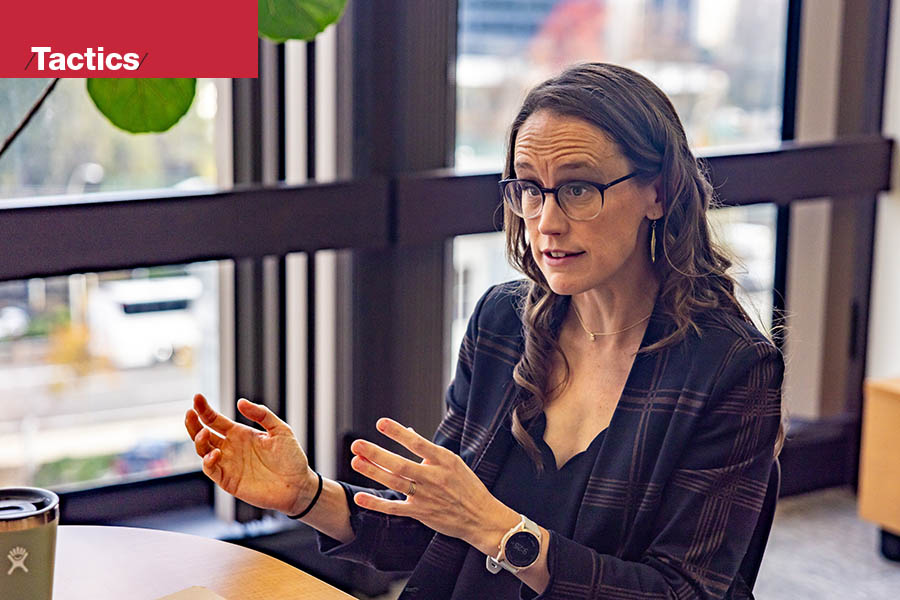The CEO of the state’s largest coordinated care organization says in 2024 Health Share and its partners will focus on improving access to behavioral health services.
In June Health Share of Oregon’s board of directors announced that it had selected Mindy Stadtlander as its CEO after serving as the organization’s interim CEO since January 2023 and as its chief operating officer since July 2020.
Stadtlander holds a bachelor of science in biochemistry from Chatham University and a master’s in public health from the University of Pittsburgh. A self-described “data nerd,” Stadtlander initially worked in scientific research but “found the social environment lacking.” After working at a federally qualified health center in Montana, Stadtlander found herself fascinated by health care access. Prior to joining Health Share, she worked at Care Oregon in a series of senior-level positions, most recently as senior vice president of Medicaid and Network Services.
Health Share is the largest of 16 coordinated care organizations, or CCOs, in the state. Created in 2011 after the passage of the Affordable Care Act, the CCOs were designed to coordinate physical, mental and dental care for Oregon Health Plan patients in a specific geographical area. Health Share — which serves Multnomah, Clackamas and Washington counties — currently serves about 460,000 patients in the tricounty area.
Stadtlander joined Health Share during a critical moment for the organization, and for health care in general. When she joined, Health Share’s enrollment was surging due to a federal Medicaid policy change. Now, with the end of the federal government’s COVID-19 emergency declaration, Stadtlander is now focusing on behavioral health, a crisis that has grown much more acute in recent years. Stadtlander spoke with Oregon Business about the data her organization has gathered and what Health Share is planning to do to tackle the problem.
This interview has been edited for space and clarity.
How were enrollment numbers affected by the pandemic?
They grew significantly. Federally, there was a hold put on redeterminations; that’s the process that people go through every year to reapply for Medicaid. So we weren’t ending Medicaid eligibility; we kept getting new people and then didn’t lose anyone else. [After our conversation, a Health Share spokesperson told OB the CCO’s enrollment grew by 27% between January 2020 and its high-water mark in July 2023.] We are just now going through the process of redetermining everybody. [Also during the pandemic], the state expanded coverage to folks who don’t have citizenship, and so saw enrollment increase. And Oregon also just got permission to keep kids until their 6th birthday covered on Medicaid — so they don’t have to reapply every year. But there are some really cool things to try to provide some stability for people and their insurance. We have about 460,000 members currently.
You’ve said that right now you are focused on behavioral health. What aspect of that are you looking at?
We’re trying to understand the size and scope of the population of people with either opioid-use disorder or a stimulant-use disorder and/or a severe and persistent mental illness. What we have found so far is that it’s not as if the population [with those disorders] has grown disproportionately pre-pandemic to now, but that the level of acuity — the complexity of what’s going on — is just much, much higher. We think it’s partially because of the kind of drugs that are in our community now, and because of challenges and access to behavioral-health services. So we’re wrapping our heads around what that means; how we identify that group of folks and how we design a better care model that works better for them across our clinical services, behavioral health and physical health hospital services — and with our housing partners.
I think one of the things that I’m hearing from a lot of people who are doing work in this space is we know the problem is really bad, and it’s a lot worse than it was, say, three to five years ago, but we don’t know how much worse, in terms of the number of people in need of acute care.
[Stadtlander referenced an analysis of Health Share’s population, conducted by the Providence Center for Outcomes Research and Education, published in November.] Nearly 10% of our adult population claims diagnosis of stimulant-use disorder, opioid-use disorder or psychosis. That is contributing significantly to the rate of inpatient hospitalizations. It’s medical beds for those conditions; it’s for other things. We’re trying to understand, what are those other things they’re being hospitalized for? It has given us an idea of the higher level of acuity behavioral-health services that we think are needed in our community, and we’re starting to talk to our partners at the county and at the state about what they’re seeing, to compare notes and align on a strategy.
When you say 10% of the adult population identifies as having a substance-abuse disorder, or severe and persistent mental illness, do you have any data to compare that to? Do you know what percentage of your population had those issues before?
Because I’m a data nerd, I’ll be precise on the words: 10% of that population has an insurance claim that has one of those. It’s probably an undercount. What we saw is in those cohorts of stimulant-use disorder, opioid-use disorder and severe and persistent mental illness — those grew by 5% to 11%, depending on which cohort you’re talking about, whereas our membership grew by more than 13% over the pandemic.
So it’s hard to compare apples to apples, then.
Yes, but it’s not that we’re seeing proportionately a lot more of folks with those conditions — certainly a little bit, but not relative to the population growth — but that the acuity is much higher.

You are starting to talk with community partners about what the need is, and how we address these problems. What are those conversations looking like? What do you think Health Share’s role is moving forward?
We’ve made a bunch of investments between Health Share and some of our partners, including Care Oregon, over the last year and a half around low-acuity, peer-led substance-use treatment centers, and each of the three Clackamas, Multnomah and Washington county investments in expanding the behavioral-
health workforce. And we’re upgrading into electronic health records. Now we’re talking about how we probably need more inpatient psychiatric service capacity and exploring with partners what that might look like, and how they might be able to build that. We’re working with a series of providers to understand what the availability is, so we build more secure residential treatment facilities. We have the estimates about how many we think we need; we’re working with OHSU in conversations about modeling what happens if we add beds in certain areas, so that we have that evidence-based, data-informed approach as we go.
This is raising the question in my head: How quickly can we start to add more beds to the system? The details are complicated, but I think everybody can agree that we need more beds.
I think that’s one of the tensions we have right now. It took us 30 years of underinvestment in the behavioral-health system to get to where we are today. I do think some patience is needed around how we are going to get out of this, knowing that these are multiyear investments. I think there are things that we can do right now, when you have housing and behavioral-health providers and mobile crisis lines taking care of the same people, and sharing information and doing a better job at care coordinating. We’re in conversations about how to move in that direction now, and doing some early pilots of that work. We’re doing some feasibility studies around what it would take to build those higher-acuity pieces, and just getting that ball moving, because we know the need is not going away in two years.
Is there anything on the horizon for 2024 that you want to talk about?
Between [the behavioral-health work] and ensuring that, in redetermination, we’re doing a good job supporting members staying on their health plan, that’s where I spend the bulk of my time.
What are you doing when you’re not working?
I have three kids. They are 13, 10 and 8, and we have an acre of property with an enormous garden. Sometimes when I’m in one-on-ones with folks that don’t require me onscreen, I’m puttering around outside. And we just got back from the first big vacation since I got the job: Over Thanksgiving weekend, we went hiking, scrambling and climbing in Red Rock just outside of Las Vegas.
Click here to subscribe to Oregon Business.








